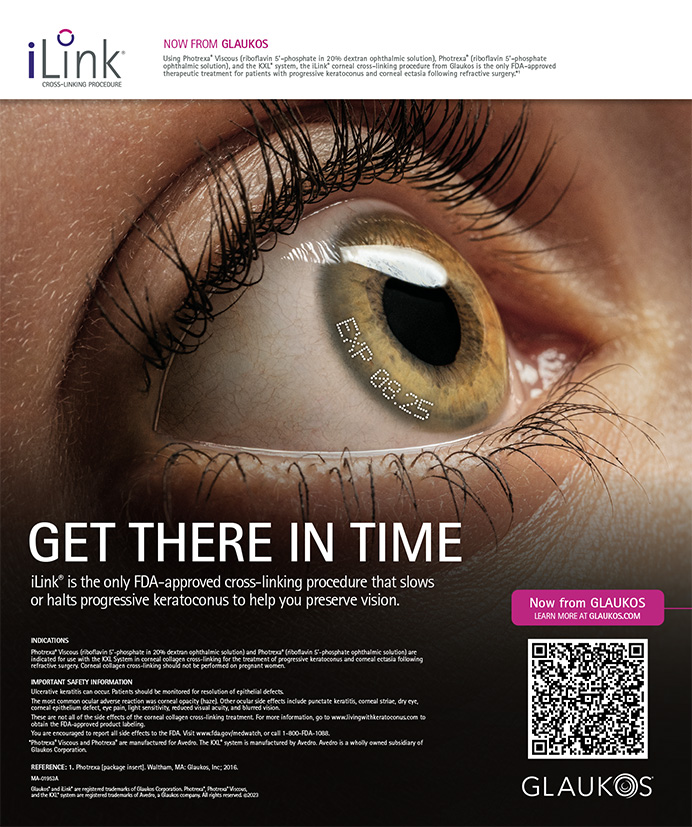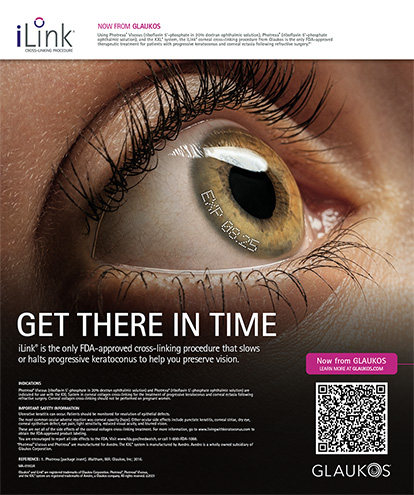Cover Stories | Nov 2005
The Knuckle Tip
Combined with phaco prechop, this tip improves the safety of refractive lens exchange.
Takayuki Akahoshi, MD
The new ultrasound Knuckle Tip (ASICO, Westmont, IL; not FDA approved) was designed for safe, rapid phacoemulsification. As a result, it is an excellent choice for refractive lens exchange.
DETAILS ON THE TIP
Thanks to its unique spherical configuration (Figure 1), the Knuckle Tip does not stick into the nucleus, and the surgeon may use ultrasound energy effectively for the phacoemulsification (Figure 2). When the tip's spherical head occludes the apical sleeve port, there is no forward flow to push the nucleus away from the tip, and the irrigation through the lateral ports provides excellent followability of the nuclear fragments (Figure 3). If the third irrigation port is made on the inferior side of the sleeve (Figure 1B), increased irrigation will help stabilize the anterior chamber and keep the posterior capsule away from the tip, thereby promoting safe phacoemulsification.
Because the tip's head has a spherical, mirror-polished, smooth surface, it can safely touch the posterior capsule during the phacoemulsification (Figure 4A). The inner edge of the tip's port has a round, smooth finish that allows the surgeon to use the same tip for nuclear removal as well as for cortical cleanup and polishing of the posterior capsule (Figure 4B). Using the tip for both nuclear and cortical removal reduces the total surgical time, because the surgeon need not change handpieces between phacoemulsification and I/A.
The bent version of the Knuckle Tip is most efficient on new ultrasound handpieces such as the Neosonix or Ozil (both by Alcon Laboratories, Inc., Fort Worth, TX), which oscillate the tip. This model of the Knuckle Tip works best for nuclei of grades 1 and 2, which can be prechopped by the karate prechop technique using a Combo Prechopper (AE-4284; ASICO, Westmont, IL). The latest Knuckle Tip can also be used with the divide-and-conquer technique.
SMALL-INCISION COAXIAL
PHACOEMULSIFICATION
Using the new Nano or Ultra Sleeve (Alcon Laboratories, Inc.), surgeons can easily and efficiently perform coaxial phacoemulsification through a sub–2.0-mm incision with the Knuckle Tip (Figures 5 through 8). They may then place an IOL such as the Restor SN60D3 lens (Alcon Laboratories, Inc.) through the same incision without enlarging it.
Surgeons may use their conventional technique and instrumentation during microcoaxial phacoemulsification. Ample irrigation through the sleeve increases surgical comfort and safety compared with sleeveless bimanual phacoemulsification. The pathological study clearly showed that the sleeve protects the wound from damage by a naked ultrasound tip.1 Thermal damage prevents the IOL's implantation through the cataract incision, which must be hydrated to seal at the conclusion of surgery. Moreover, a damaged wound that does not seal properly may result in a higher degree of astigmatism and incidence of endophthalmitis than with a normal incision. In contrast, the surgeon can easily seal a wound protected by the sleeve at the end of the surgery simply by increasing the IOP with BSS Plus (Alcon Laboratories, Inc.). Stromal hydration is unnecessary (Figure 8E).
PHACO PRECHOP
For refractive lens exchange, minimizing the amount of surgically induced astigmatism is mandatory. To that end, the Knuckle Tip and Nano or Ultra Sleeve are a choice combination. Reducing the amount of the ultrasound energy used to remove the cataract is also important for protecting the wound.
Phaco prechop is an excellent option for refractive lens exchange. When using this approach, the surgeon should protect the cornea by means of the soft shell technique with a cohesive and a dispersive viscoelastic (Figure 6A), make a complete capsulorhexis that is slightly smaller than the optic's size (Figure 6B), and perform sufficient hydrodissection with the Hydrodissection Cannula (AE-7636; ASICO) to allow the nucleus to rotate freely in the capsular bag (Figure 6C).
For nuclei of grades 1 and 2, karate prechop with a Combo Prechopper is useful, because soft nuclei are often difficult to address with conventional chopping techniques. In a downward direction, the surgeon inserts the angular, sharp side of the Combo Prechopper into the nucleus at its center. The surgeon can easily divide the nucleus into two pieces along the lens-fiber construction by opening the prechopper's blades (Figure 7A). The rounded, blunt blade can safely prechop the posterior plate of the nucleus. After rotating the nucleus 90º, the surgeon may repeat the procedure to divide the nucleus into four pieces—without using any ultrasound energy.
The Paddle Prechopper (AE-4283; ASICO) is another useful option for prechopping soft nuclei. For nuclei that are too dense for the insertion of a prechopper or for eyes with weak zonules or an incomplete capsulorhexis, the surgeon should support the nucleus with a Nucleus Sustainer (AE-2530; ASICO) and prechop it by means of the counter prechop technique with a sharp Universal Prechopper (AE-4282; ASICO).
The linear burst mode on the Infiniti Vision System (Alcon Laboratories, Inc.) is useful for reducing the ultrasound energy required for removing the cataract. The burst width is preset according to the nuclear density. The surgeon uses 5 milliseconds of burst for nuclei of grade 1, 10 milliseconds for grade 2, 20 milliseconds for grade 3, and 30 milliseconds for grade 4. In linear burst mode, the foot pedal controls the interval of the bursts and provides linear control of the ultrasound power. In this fashion, the surgeon can minimize the total use of ultrasound energy.
COUNTERTRACTION IMPLANTATION
TECHNIQUE
Using a conventional Monarch C cartridge (Alcon Laboratories, Inc.) and a Royale II injector spring model (AE-9045SP; ASICO), the surgeon can inject an Acrysof single-piece IOL (Alcon Laboratories, Inc.) with a 6-mm optic through a sub–2-mm incision. The ophthalmologist holds the bulbar conjunctiva with the Universal Forceps (AE-4180; ASICO) on the opposite side of the incision and provides a counter force to the cartridge before injecting the IOL through the cataract incision (Figure 8B). One may also use a Nucleus Sustainer (ASICO) to provide a counter force from the sideport incision. It is important to fill the anterior chamber with a viscoelastic such as Provisc (Alcon Laboratories, Inc.) to keep the eye firm during the IOL's insertion.
CONCLUSION
By employing phaco prechop, linear-bust phacoemulsification, a Knuckle Tip, and the Nano or Ultra Sleeve, surgeons can perform superb microcoaxial phaco surgery. The countertraction implantation technique allows the implantation of the Acrysof Single-Piece lens through an incision less than 2mm long. These technologies improve the safety and efficiency of refractive lens exchange.
Takayuki Akahoshi, MD, is Director of Ophthalmology at Mitsui Memorial Hospital in Tokyo. He states that he holds no financial interest in the products or companies mentioned herein. Dr. Akahoshi may be reached at +81 3 3862 9111; eye@phaco.jp.
1. Vasavada AR. Phaco tips and corneal tissue. Cataract & Refractive Surgery Today. 2005 June;5:6(suppl):9-10.


